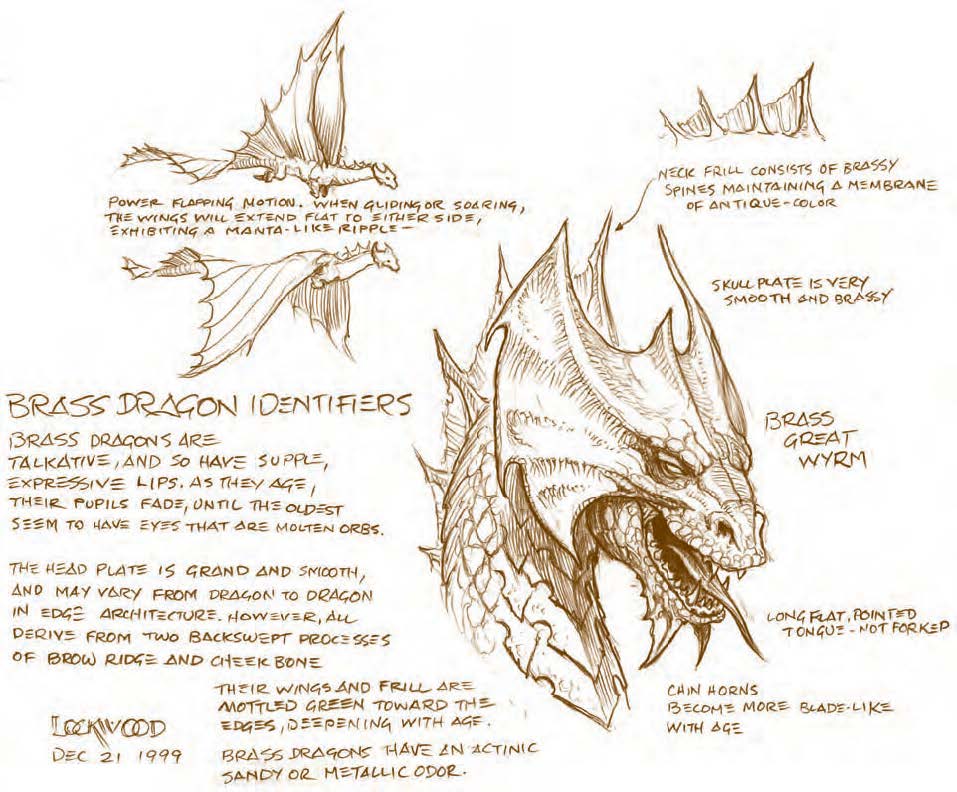Brass Dragon
The most gregarious of all the true dragons, brass dragons are famous (some would say infamous) for their love of conversation. They crave sunlight and dry heat, so they frequent hot, arid regions, particularly sandy deserts. Their choice of terrain often puts them at odds with blue dragons, which are both more powerful and more aggressive. Brass dragons usually cope with attacking blues by using their superior speed to escape, either through the air or by burrowing to safety.
Brass dragons like to make their lairs in high, rocky caves, preferably facing east so the rising run can warm the rocks. Most brass dragons also have several bolt-holes dug into the bases of cliffs where the desert winds have piled up sand. The dragons burrow tunnels parallel to the cliff face in the hard-packed sand. They can move quickly along these tunnels, exiting into subterranean caverns, or out other burrows farther down the line.
Dungeon-dwelling brass dragons often make their lairs near heavily traveled areas where they can satisfy their desire for conversation.
Brass Dragon Identifiers
A brass dragon’s head has a massive, fluted plate sweeping back from its eye sockets, forehead, and cheeks. The onepiece plate is dished like a plowshare. When burrowing in the sand, the dragon often uses its head like a plow. A brass dragon also sports bladed chin horns that grow sharper with age. It has supple, expressive lips and a long forked tongue. As the dragon grows older, its pupils fade until the eyes resemble molten metal orbs. A brass dragon has a tangy odor redolent of hot metal or desert sand. Brass dragons have short, raylike wings that run from their shoulders all the way back past the tips of their tails. The wings get most of their support from long spines running perpendicular to the backbone. The neck is stubby and thick, with a comparatively long body. When the body is viewed from below, the chin horns are visible. At birth, a brass dragon’s scales are a dull, mottled brown. As the dragon gets older, the scales become more brassy until they reach a warm, burnished appearance. The wings and frills are mottled green where they join the body, and have reddish tints at the outer edges. These markings darken with age.Habits
Brass dragons can and will eat almost anything if the need arises, but they normally consume very little. They seem to understand that the desert is a fragile environment, and they live lightly upon the land. They are able to get nourishment from the morning dew, a rare commodity in the desert, and they go forth at dawn to gently lift minute beads of dew off plants with their long tongues. Though it values all precious things, a brass dragon prefers organic treasures over cold stone or metal. Its hoard often includes items made from rare woods, textiles, and other examples of fine handicrafts rendered in exquisite materials. The warm, dry air of its lair helps keep these delicate treasures from deteriorating with age. A brass dragon takes great care to keep its fiery breath weapon well away from its delicate treasure, and often keeps its hoard in a separate chamber within its lair. Brass dragons love intense, dry heat and spend most of their time basking in the desert sun. Their territories always contain several spots where they can sunbathe and trap unwary travelers in conversation. A brass dragon will talk for hours with any creature capable of putting two syllables together. Many scholars believe that brass dragons are the most humble of the true dragons. While any brass dragon certainly will agree that humility is among its many virtues, a brass dragon’s loquacity is really a form of draconic hubris. Brass dragons consider themselves such gifted conversationalists that they simply cannot bear to allow any sentient being to miss the benefit of their company. For all their love of conversation, what brass dragons seem to prefer the least is the company of other brass dragons. Each one remains in loose contact with its neighbors, and brass dragons will band together whenever a common enemy threatens, but otherwise they keep to themselves. Many brass dragons create vast networks of confidantes and informants, including djinn, jann, sphinxes, and various humanoids. The dragons use these networks to keep apprised of local events and to stay in remote communication with distant brass dragons. Brass dragons would rather talk than fight. If an intelligent creature tries to leave without engaging in conversation, the dragon might force compliance in a fit of pique, using suggestion or a dose of sleep gas. Though basically friendly, brass dragons are quick to act if they feel threatened, and often use their nonlethal sleep breath to knock out aggressors. A creature put to sleep may wake to find itself pinned or buried to the neck in the sand. The dragon then converses with its prisoner until its thirst for small talk is slaked. When faced with real danger, younger brass dragons fly out of sight, then hide by burrowing into the sand. Older dragons spurn this ploy but tend to avoid pitched fights unless they have some tactical advantage.Sources:
- Dungeons & Dragons Draconomicon (3.5 Edition, 2009).
- Monster Manual, Brass Dragon
Related Ethnicities




Comments